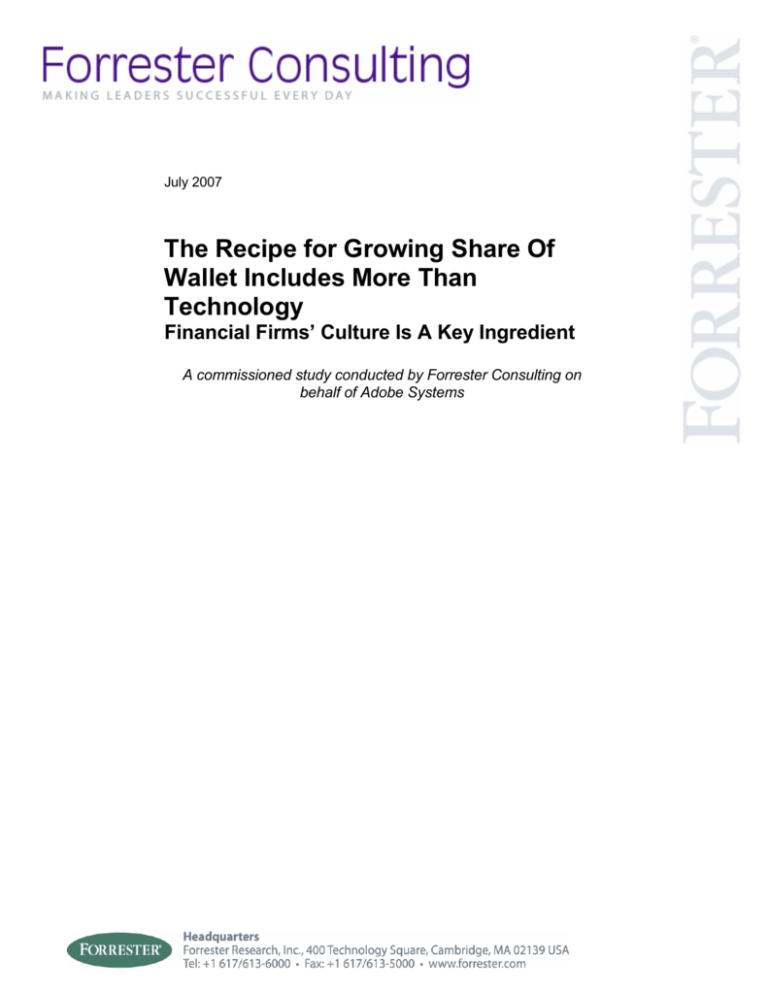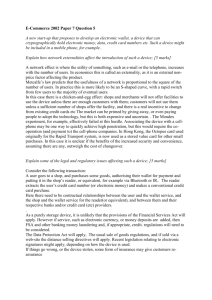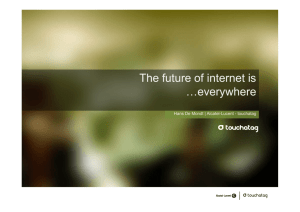The Recipe for Growing Share Of Wallet Includes More
advertisement

July 2007 The Recipe for Growing Share Of Wallet Includes More Than Technology Financial Firms’ Culture Is A Key Ingredient A commissioned study conducted by Forrester Consulting on behalf of Adobe Systems Growing Share of Wallet Introduction Financial services firms are competing for their customers’ share of wallet — trying to be the primary and ultimately sole provider to them. Competition is tough, because customers tend to shop around for the best deal (see Figure 1). In addition, consumers have conflicting instincts: a desire for the simplicity of having one or two providers battles against a hesitation not to have “all their eggs in one basket”. As a result, financial firms need to make some compelling arguments to get more of their customers’ business. Figure 1: Consumers shop around for financial products Figure 1-1: 45% of US consumers researched financial products in 2006 From the April 3, 2007 “Turning Pricing Optimization Into Relationship-Based Pricing “ Figure 1-2: High rates of European consumers shop around for their financial services From the April 3, 2007 “Turning Pricing Optimization Into Relationship-Based Pricing “ Technology Is Still The Primary Barrier Despite the fact that supporting technology is commonplace in the market today, financial firms still indicate that the lack of a 360° view of the customer is a primary barrier to growing share of wallet, according to the results of a global survey of banks and investment firms commissioned by Adobe Systems and conducted by Forrester Consulting. Respondents were asked to -2- Growing Share of Wallet indicate — on a scale of one to five — to what extent seven issues related to share of wallet were problems for them.1 While there were no significant standouts where respondents agreed, when they were asked to identify which of the issues posed the greatest challenge, the statement “We don’t have a complete consolidated view of the customer relationship, so it is difficult to determine what products are good offers for them” was chosen most often (see Figure 2). Why is this, given that financial institutions have been focusing on this issue for over ten years? Here are some key reasons that banks and investment firms still haven’t fully succeeded in developing this capability: Mergers and acquisitions have slowed the consolidation of customers into single profiles, given the multitude of customer information files (CIFs) that have to be united. Subsidiaries like mortgage and credit card groups still maintain their own, separate CIFs, and marketing data bases often only capture the fact that accounts there exist and do not include account details like balance, rate, and terms. Details on investments such as annuities are often held only at the originating insurance company, even though the product might have been sold through an investment firm or bank. Again, only the fact that a customer has an annuity is often available in the CIF. Financial firms continue to work towards a full view, but this project is often prioritized well below other current challenges such as meeting compliance and regulatory requirements. Figure 2: Lack of 360° Customer View And Lack of Focus On Retention Were Top Issues What are your two highest priority issues related to expanding wallet share among customers? Issue of primary concern 11% 17% Lack of consolidated customer view Too much focus on growing wallet share, not enough on retention 13% Cross selling is difficult as customers don't want to put all their eggs in one basket 12% No value based pricing 11% Referring existing customers to the correct product specialist is difficult 11% Most client interaction is during servicing issues - not a good time for cross-selling Marketing offer management system doesn't target the right products to the right customer Issue of secondary concern 8% 4% 8% 4% 8% 5% 11% 8% Base: Respondents reporting facing issues around growing share of wallet. n=58 Source: Phone survey of 76 decision-makers with responsibility for customer-centric applications across multiple channels in large banks and investment firms. Survey commissioned by Adobe and conducted by Forrester Consulting, February and March 2007 -3- Growing Share of Wallet Aligning Share Of Wallet Growth With Retention Is Critical The other key issue that was highlighted in the survey results was a lack of focus on retention at their institutions. Over 20% of the respondents scored the statement, “We focus too much on growing share of wallet, and not enough on retaining our existing customers,” as their first or second challenge. Even with a renewed focus on retention active in the market today, financial firms aren’t necessarily aligning strategies for retention with those for growing wallet share. As expected, the barriers to this alignment are associated with people, process, and technology, but the survey results indicated that people, culture, and company combine to serve as the primary impediment (see Figure 3). Here are the core factors behind this organizational challenge: Many financial firms are still product-centric, rather than customer centric, so product managers are rewarded for selling more product units rather than on retaining the existing relationships. These firms may be satisfied with the fact that as long as the number of accounts on file continues to grow, they are selling faster than they are losing customers. Line of business silos often are still prevalent in banking and investment firms, so even if the LOB marketing group is focusing on retention as well as sales, the efforts may not be coordinated across the different business lines. Retention is hard to track, and equally difficult to reward. Consider the front line sales and service representative: She is generally goaled on new product sales and some service level (be it using customers’ names, or being fast and accurate with their transactions.) But it’s a rare program where these representatives are goaled on — and rewarded for — saving account relationships. Frankly, with a line of potential sales waiting, it’s often fastest and easiest just to handle the request when someone wants to close his account. Figure 3: 360° View Is a Technology Challenge, but Retention Focus is Culture Related Thinking about your highest priority challenges, what proportion of the challenges would you attribute to Process, Technology, or People/Company Culture? Too much focus on growing wallet share, not enough on retaining customers Difficulty cross-selling appropriate products and services due to lack of consolidated customer view People, Culture, Company 22% Process 25% People, Culture, Company 34% Process 28% Technology 23% Technology 53% Base: Respondents reporting “Difficulty cross-selling appropriate products and services due to lack of consolidated customer view” as their first or second greatest challenge. n=19 Base: Respondents reporting “Too much focus on growing wallet share, not enough on retaining customers” as their first or second greatest challenge. n=16 Source: Phone survey of 76 decision-makers with responsibility for customer centric applications across multiple channels in large banks and investment firms. Survey commissioned by Adobe and conducted by Forrester Consulting, February and March 2007 -4- Growing Share of Wallet People, Process, And Technology Come Together For Growth Growing share of wallet successfully can be supported through a comprehensive strategy that addresses all key areas of the issue — people, process, and technology. The survey results showed that 63% of respondents who indicated a priority challenge with the lack of a consolidated 360° client view — which respondents said is primarily a technology oriented problem — are currently addressing the issue, and another 21% are planning to address it. But surprisingly, nearly one third of the respondents who identified the lack of focus on retention as a problem have no plans to address this challenge (see Figure 4). With competition growing fiercer, financial firms that continue with a strategy reliant upon on new sales to outpace the loss of existing accounts will eventually lose the battle of accounts on file. This is especially true in light of the fact that as competition grows, companies are increasingly forced to focus on luring back customers they have already lost. That’s a much harder chore than acquiring a new customer. Figure 4: A Surprising Number Have No Plans To Address The Retention Challenge Is this an issue that you are addressing? Difficulty cross-selling appropriate products and services due to lack of consolidated customer view Too much focus on growing wallet share, not enough on retaining customers Plans to address in future 6% Don't Know 13% Plans to address in future 21% Currently addressing 63% No plans to address 31% No plans to address 16% Respondents have been addressing multiple core systems issues for an average of 15 months. Currently addressing 50% Respondents have been addressing continuity across channels issues for an average of 10 months. Base: Respondents reporting “Having too many core systems makes modifying them too slow a process” as their first or second greatest challenge. n=28 Base: Respondents reporting “Too much focus on growing wallet share, not enough on retaining customers” as their first or second greatest challenge. n=16 Source: Phone survey of 76 decision-makers with responsibility for customer centric applications across multiple channels in large banks and investment firms. Survey commissioned by Adobe and conducted by Forrester Consulting, February and March 2007 Without an enterprise strategy for share of wallet, firms won’t be able to move past the competing efforts they have today: technology, without appropriate cultural incentive to use it optimally, is inconsequential; processes, without the right technology behind them, can’t be as effective; and people can work and try very hard, but without the suitable technology and processes, can’t achieve what they could. Here are some key things to think about when building your integrated share of wallet strategy: -5- Growing Share of Wallet People/Culture/Organization Process Technology • Re-evaluate your • Re-evaluate your customer • Break down the barriers organizational structure: facing processes: Are they to the consolidated Are you product centric or designed with the customer customer view and apply people centric? in mind? the right technologies to deliver it. • Define a champion for the • Simplify processes for integrated strategy to serve as the executive evangelist. problem resolution and other customer pain points to reduce the desire for them to attrite. • Re-define your incentive programs for all staff • Build specific processes members involved in around retention — selling products (from the including how to identify product manager to the those likely to leave, and front line sales person). methods to counteract that Ensure there are rewards impulse. Don’t forget to to support your strategy. build a process for measuring results. • Use analytics to support growth and retention strategies — including real time offer management. • Consider broad-range capabilities like price optimization and relationship-based pricing tools to support your integrated strategy. Conclusion Growing customer wallet share is one of the most difficult fights financial firms have today, and approaching it with tunnel vision or piecemeal won’t help these companies gain the success they are after. The survey results support what many think of as common sense: Success with sales growth is only effective if you retain your customers. Without the right technology, processes, and cultural focus, even solidly aligned strategies will have limited success. Make it a priority for front line staff to identify retention triggers and try to resolve the customers’ objections. But give them clear, effective processes and the supporting technology to get the job done. 1 The survey, commissioned by Adobe Systems and conducted by Forrester Consulting, was conducted in North America, the UK, and Western Europe during the period of late January through mid-March, 2007 by phone, with 76 respondents at the executive level in the businesses and IT. Eight-four percent of the respondents were from banks, and 16% from investment firms. -6-







